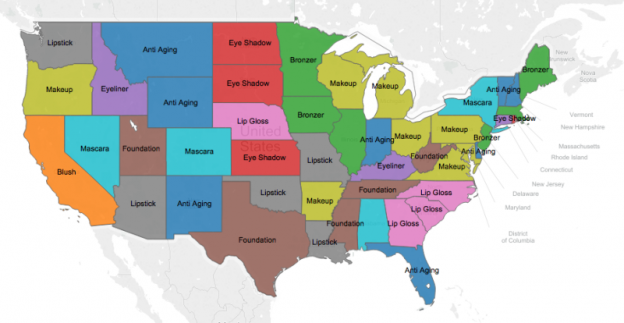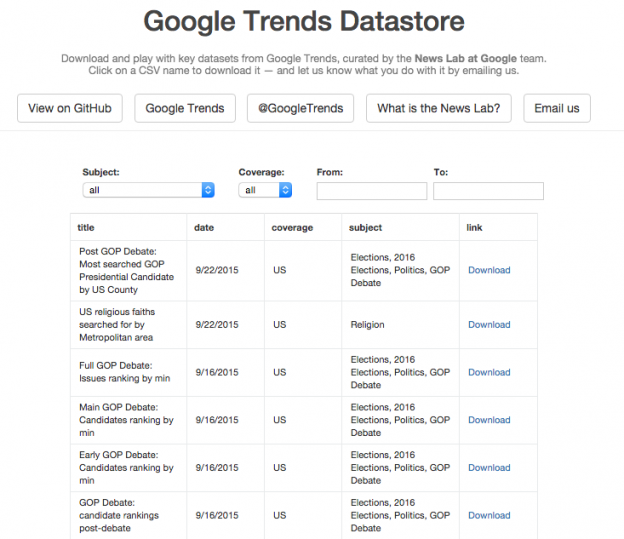
Google Trends is a unique and useful tool for journalists to keep track of what people want to know about. But it’s also invaluable for companies watching their brand health and analyzing consumer interests for the purposes of content creation – even though most users only scratch the surface of the wealth of information Google Trends has to offer.
That being said, here are seven ways to use Google Trends you’ve never thought of before, leveraging some of the service’s newly released and often-underused features:
Dig deeper into trending topics
Google Trends now boasts a “story-centric” homepage, where it aggregates data from Google Search, YouTube and Google News and ranks the most searched for stories. This is by far the most comprehensive trends aggregate you’ll find on the web.
trending topics
So if I click on iOS Apple Inc., which is number 3 on the trending list above, I’m taken to a dashboard about the story everyone’s talking about: a security flaw in iOS 9 & iOS 9.0.1.
The dashboard shows me the relevant articles on the topic, a trending video, as well as changes in interest in the topic over the past few days.
trending list
If your business is in the tech niche, then this would be a great opportunity for content creation – posting a piece on a widely trending topic will help draw traffic to your site. You can even make sure that you capitalize on the topic when you see evidence that interest is growing.
Find real-time marketing opportunities
Google Trends is now offering minute-by-minute, real-time data from more than 100-billion searches through the engine monthly, which allows you to evaluate search trends during different times, or even at major events, such as the Oscars or the World Cup. You can choose any time period from the past week to see the minute-by-minute data.
So how can you use this data for real-time marketing? By watching spikes in search terms during major events, you can quickly determine what topics are grabbing people’s interest.
A classic example of real-time marketing using Google Trends information comes from Oreo’s timely tweet during Super Bowl in 2013, when the lights went out in the New Orleans Superdome for 34 minutes.
Power out? No problem. pic.twitter.com/dnQ7pOgC
— Oreo Cookie (@Oreo) February 4, 2013
Oreo’s marketing team threw this ad together on the fly. Twitter users loved it and shared it — the single tweet has had more than 15,000 retweets up to today.
Think about events that would be a good marketing venue for your brand and look for fast opportunities to employ real-time marketing to increase your brand’s reach on social media.
Research niche topics by geography
Now, you can search for just about any topic in Google Trends and see the popularity of the topic in searches by geography. If you haven’t started a local marketing campaign yet, this is a great place to begin. If you’re hoping to expand or improve it, this is also a great resource.
Let’s say I’m an organic chicken distributor looking to expand my business. Where should I set up shop?
Just type “organic chicken” into Google Trends and it comes up with helpful data about regional interest in the search term, including a ranking of search by city.
Google Trends
So if I already have locations in Vancouver, Portland and Seattle, San Francisco might be a viable option for me.
I can also dig deeper by scrolling down and looking at the related searches that might apply to my product (such as “buy organic chicken”) or other products I offer (“organic chicken food”).
google trends 2
Click on any of these items to see their niche topic details, including super-helpful geographic data.
Research brand health
Google Trends is a great way for larger brands to understand their brand health compared to their competitors. This kind of information can help inform where companies need to work harder to increase their influence.
Let’s say I work with Nissan, and I want to see how our brand measures up to other auto companies in the state of Florida. I just set the following terms on my Google Trends search:
Google Trends search
And instantly, I can see the top auto/vehicle queries for Florida in the last 30 days.
google trends 3
Looks like Ford, Honda and Toyota are doing better in this state, so I know I’ve got some work ahead of me. Depending on the goals you have for your brand, you can also search by certain city in Florida, by the entire US, by a different country, or worldwide.
Research local shopping trends
Another great (and underused) feature of Google Trends is the ability to search for shopping trends in isolation. This data will show you consumers’ purchasing intent for different searches. If you’re a realtor, or looking to be one, this kind of information can be very valuable.
Check out this map put together by Benjamin Spiegel from Marketing Land:
Benjamin Spiegel map
To create this compelling graphic, he searched Google Shopping for the highest purchase intent for beauty products for each state last February. The resulting map shows us the products people most want to buy in these states.
If you sell beauty products, this data could show you where you’ll get the most value for your advertising spend. Adjust your marketing and content campaigns to match the demand in each market.
Brainstorm content with Google Correlate
Google Correlate can help you figure out what topics people want to read about, which can ultimately help you figure out what topics you should be writing about, or how to relate a topic to others that people are interested in.
Using Google Correlate, you can find associations between search trends and any other data point that you want to write about. It’s the only tool on the internet that can do this with search data, yet it goes largely unused.
The Google tutorial explains that Correlate is like the opposite of Trends:
Google Correlate is like Google Trends in reverse. With Google Trends, you type in a query and get back a data series of activity (over time or in each US state). With Google Correlate, you enter a data series (the target) and get back a list of queries whose data series follows a similar pattern.
Let’s say I run a niche blog for baking recipes, and I want to draw more traffic to my site. I can type “baking” into Google Correlate:
Google Correlate
And I see instantly that baking has a pretty high correlation with the search terms “egg free,” “sausage,” and “broccoli.” Knowing this, I might decide to write up some new recipes with these ingredients in mind, since that’s where search interest lies.
If you’re statistically inclined, Google Correlate even allows you to upload your own dataset to see what search terms correlate with it. Just click the “Enter your own data” link next to the search bar and upload your Excel file.
Let Google do the analysis for you
In a recent change to Google Trends, the Google News Lab has begun doing their own analyses of trending stories every day and offering useful information about the topics, which you can download from the Google Trends Datastore. If you’re a journalist or content creator, or if you have one on your team, this can be an invaluable tool.
What if I’m writing a story about the latest GOP debate? I can use this tool to find data about the most searched for GOP candidate by county, the debate issues ranking by minute, and the candidates’ rankings post-debate, among many other relevant topics that can serve as useful statistics to add meat to the story.
Google Trends Datastore
This is a great way to add credibility to what I’m going to say in a written piece about public interest, without waiting for the next Gallop Poll.
So those are my favorite seven new or underused features of Google Trends that you can use to develop a marketing strategy, improve your SEO, or brainstorm content.
It might be difficult to visualize how exactly you can apply these tools to your own business goals, which is why I recommend trying them out and checking back often – opportunities will arise and the ways to stay on top of the game are endless.
Have you ever experimented with these Google Trends features? Have another great tool to share? Leave me a note in the comments section below:
Note: The opinions expressed in this article are the views of the author, and not necessarily the views of Caphyon, its staff, or its partners.
Author: Aaron Agius